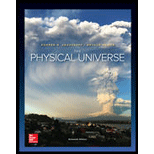
Concept explainers
Which of the following quantities is not a vector quantity?
- a. velocity
- b. acceleration
- c. mass
- d. force
The quantities which are not vectors.
Answer to Problem 1MC
Option (c) mass.
Explanation of Solution
Physical quantities can be of two categories, scalars and vectors.
Scalars are those quantities that can be defined fully using their magnitudes. These quantities does not require direction. Few of the examples of scalar quantities are speed, volume and temperature.
Vectors require both magnitude and direction of the quantity to describe it completely. Vector can be represented using an arrow showing the direction of the quantity and the length of the arrow is proportional to the quantity’s magnitude. The examples of vectors include momentum, displacement and electric field.
Conclusion:
The quantity, mass, can be explained completely using just the magnitude of the quantity. So, mass is not a vector quantity. Thus, option (c) is correct.
Velocity has both magnitude and direction. Thus, velocity is a vector quantity. Thus, option (a) is incorrect.
Acceleration needs both magnitude and direction in order to give its complete meaning. Thus, velocity is a vector quantity. Thus, option (b) is incorrect.
Force is a physical quantity with both magnitude and direction. So, force is a vector quantity. Thus, option (d) is incorrect.
Want to see more full solutions like this?
Chapter 2 Solutions
Physical Universe
- In a certain region of space the electric potential is given by V=+Ax2y−Bxy2, where A = 5.00 V/m3 and B = 8.00 V/m3. Calculate the direction angle of the electric field at the point in the region that has cordinates x = 2.50 m, y = 0.400 m, and z = 0. Please explain. The answer is not 60, 120, or 30.arrow_forwardAn infinitely long line of charge has linear charge density 4.00×10−12 C/m . A proton (mass 1.67×10−−27 kg, charge +1.60×10−19 C) is 18.0 cm from the line and moving directly toward the line at 4.10×103 m/s . How close does the proton get to the line of charge?arrow_forwardat a certain location the horizontal component of the earth’s magnetic field is 2.5 x 10^-5 T due north A proton moves eastward with just the right speed so the magnetic force on it balances its weight. Find the speed of the proton.arrow_forward
- Example In Canada, the Earth has B = 0.5 mT, pointing north, 70.0° below the horizontal. a) Find the magnetic force on an oxygen ion (O) moving due east at 250 m/s b) Compare the |FB| to |FE| due to Earth's fair- weather electric field (150 V/m downward).arrow_forwardThree charged particles are located at the corners of an equilateral triangle as shown in the figure below (let q = 2.20 µC, and L = 0.810 m). Calculate the total electric force on the 7.00-µC charge. What is the magnitude , what is the direction?arrow_forward(a) Calculate the number of electrons in a small, electrically neutral silver pin that has a mass of 9.0 g. Silver has 47 electrons per atom, and its molar mass is 107.87 g/mol. (b) Imagine adding electrons to the pin until the negative charge has the very large value 2.00 mC. How many electrons are added for every 109 electrons already present?arrow_forward
- (a) Calculate the number of electrons in a small, electrically neutral silver pin that has a mass of 13.0 g. Silver has 47 electrons per atom, and its molar mass is 107.87 g/mol.arrow_forward8 Two moving charged particles exert forces on each other because each creates a magnetic field that acts on the other. These two "Lorentz" forces are proportional to vix (2 xr) and 2 x (vi x-r), where is the vector between the particle positions. Show that these two forces are equal and opposite in accordance with Newton's third law if and only if rx (vi × 2) = 0.arrow_forward6 The force = +3 + 2k acts at the point (1, 1, 1). Find the torque of the force about (a) (b) the point (2, -1, 5). Careful about the direction of ŕ between the two points. the line = 21-+5k+ (i-+2k)t. Note that the line goes through the point (2, -1, 5).arrow_forward
- 5 Find the total work done by forces A and B if the object undergoes the displacement C. Hint: Can you add the two forces first?arrow_forward1 F2 F₁ -F₁ F6 F₂ S A Work done on the particle as it moves through the displacement is positive. True False by the force Farrow_forwardA student measuring the wavelength produced by a vapour lamp directed the lightthrough two slits with a separation of 0.20 mm. An interference pattern was created on the screen,3.00 m away. The student found that the distance between the first and the eighth consecutive darklines was 8.0 cm. Draw a quick picture of the setup. What was the wavelength of the light emittedby the vapour lamp?arrow_forward
 Physics for Scientists and Engineers, Technology ...PhysicsISBN:9781305116399Author:Raymond A. Serway, John W. JewettPublisher:Cengage Learning
Physics for Scientists and Engineers, Technology ...PhysicsISBN:9781305116399Author:Raymond A. Serway, John W. JewettPublisher:Cengage Learning Physics for Scientists and Engineers: Foundations...PhysicsISBN:9781133939146Author:Katz, Debora M.Publisher:Cengage Learning
Physics for Scientists and Engineers: Foundations...PhysicsISBN:9781133939146Author:Katz, Debora M.Publisher:Cengage Learning Principles of Physics: A Calculus-Based TextPhysicsISBN:9781133104261Author:Raymond A. Serway, John W. JewettPublisher:Cengage Learning
Principles of Physics: A Calculus-Based TextPhysicsISBN:9781133104261Author:Raymond A. Serway, John W. JewettPublisher:Cengage Learning College PhysicsPhysicsISBN:9781938168000Author:Paul Peter Urone, Roger HinrichsPublisher:OpenStax College
College PhysicsPhysicsISBN:9781938168000Author:Paul Peter Urone, Roger HinrichsPublisher:OpenStax College University Physics Volume 1PhysicsISBN:9781938168277Author:William Moebs, Samuel J. Ling, Jeff SannyPublisher:OpenStax - Rice University
University Physics Volume 1PhysicsISBN:9781938168277Author:William Moebs, Samuel J. Ling, Jeff SannyPublisher:OpenStax - Rice University Physics for Scientists and EngineersPhysicsISBN:9781337553278Author:Raymond A. Serway, John W. JewettPublisher:Cengage Learning
Physics for Scientists and EngineersPhysicsISBN:9781337553278Author:Raymond A. Serway, John W. JewettPublisher:Cengage Learning





